Although big data is ever-present in our lives, it can be difficult to understand how much it really has changed our day-to-day living. Let’s take a closer look at how big data has weaved its way into the lives of many consumers today, via the Internet of Things (IoT).
The Internet of Things can be thought of as the inter-connectivity of everyday objects that use network connectivity to send and receive data. Whether we consciously realize it or not, we are surrounded by objects like these that depend on big data to make our lives better.
Here are a few popular IoT examples:
Waking You Up – LIFX, ilumi, GE
Many people across the globe begin their day with big data. Rather than being awoken by an annoying ringtone blaring from their smart phone, these smart lighting enthusiasts prefer to be gently woken by a soft increase in lighting that mimics the sunrise.
The smart lighting segment is growing rapidly, both in terms of technical progress and popularity. LIFX, ilumi and GE are just a few examples of companies that have jumped on the smart light bandwagon. With big data, smart lighting is advancing its potential and use cases through the use of sensors and machine learning technology. Consumers are waking up, making reminders, setting the mood, enhancing security and going to sleep—all with the help of these fancy little lightbulbs.
Smart mattresses are another change that is improving our sleep in surprising ways. They are equipped with a number of devices and sensors that can help us, such as adjusting the temperature to help reach deep REM.
Controlling Your Home’s Climate – Nest
Modern technology has made it possible to control the temperature in our homes with stunning accuracy. Today, consumers have the option of controlling their heating and cooling systems with machine learning technology.
Products like the Nest Thermostat have made it their mission to eliminate as much of the human administration of climate control as possible, while optimizing comfort. With machine learning and sensory technology, the Nest gathers data about its owner’s home temperature preferences. It then programs itself to optimize the living conditions to fit those preferences. In addition to auto-programming, the Nest will also change the temperature settings when its owners are away from the home in order to minimize monthly cooling/heating expenses—pretty impressive for a mere thermostat.
Staying Fit – Fitbit, Basis, Jawbone
There have been a lot of advancements in the health and fitness (wearables) category. Everyone wants to be strong and healthy, but few of us have the tools to make this a lifelong goal. This desire has fueled the development of countless wellness innovations. Big data has made a grand entrance into this space with the introduction of smart health trackers. Fitbit, Basis and Jawbone have developed three of the leading wearable data devices for health and fitness. These devices, among others, help users track data such as calories burned, activity level, distance traveled, sleep quality, heart rate, and much more. By using coordinating programs, these wearables help users develop customized health goals and paths to reach them.
Helping You Sleep – SleepIQ
A large percentage of adults and children today don’t get enough sleep. This silent epidemic is causing dangerous health and social repercussions. One of the newest solutions on the market involves the use of big data to help consumers get a better night’s sleep.
One such product is Sleep Number mattresses with SleepIQ technology. The big data technology that makes this possible includes sensors that work directly with the DualAir technology inside the Sleep Number bed. There’s nothing to wear or turn on; all consumers have to do is sleep. By simply sleeping on their mattresses, SleepIQ consumers are tracking their breathing rate, heart rate movement and more. The technology then aggregates this data into a sleep score. It also develops sleep goals and recommendations for the user based on the historical data it gathers.
Monitoring Your Baby – Owlet
Parents today are excited by advanced baby monitoring options that never existed before big data. Instead of using a simple one way baby monitor, companies like Owlet have introduced baby monitoring devices that give parents more information on their child’s well being than ever before. With sensory bracelets embedded in socks, parents can see a live feed of their child’s heart rate, oxygen level, skin temperature, sleep quality and movement. With the ongoing risk of SIDS and other infant related illnesses, this level of monitoring provides a comprehensive peace of mind. Learning more about these IoT devices makes big data a lot more tangible, doesn’t it? These “smart” products using big data technologies are capable of affecting the lives of everyone living in the modern world today. Big data is here—in your home, your car, on your body; as you sleep, as you wake, and as you live. It is all around you; all you have to do is notice it.








